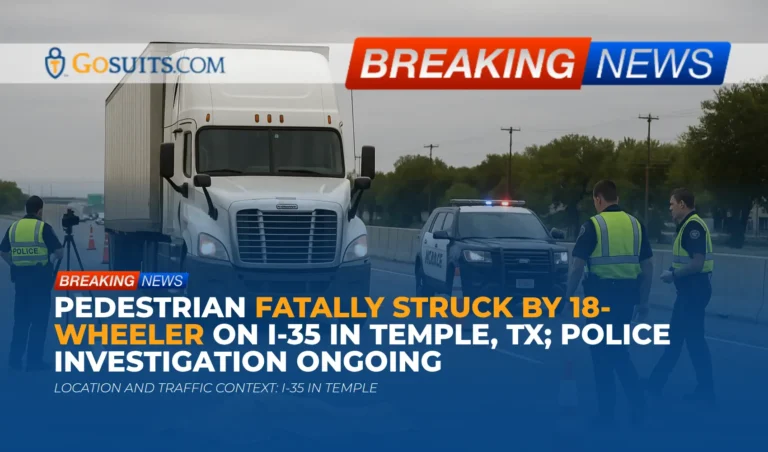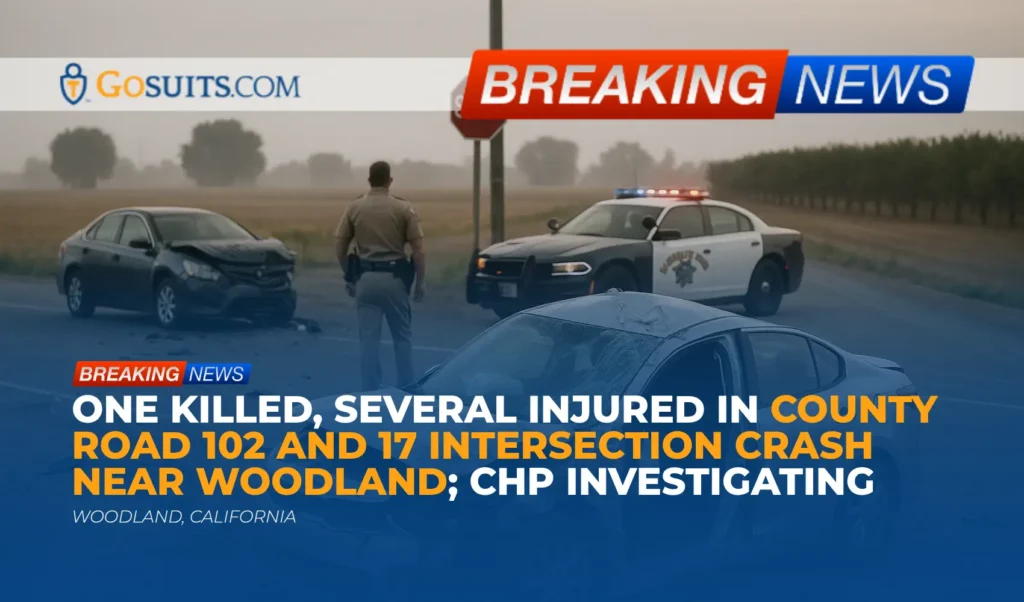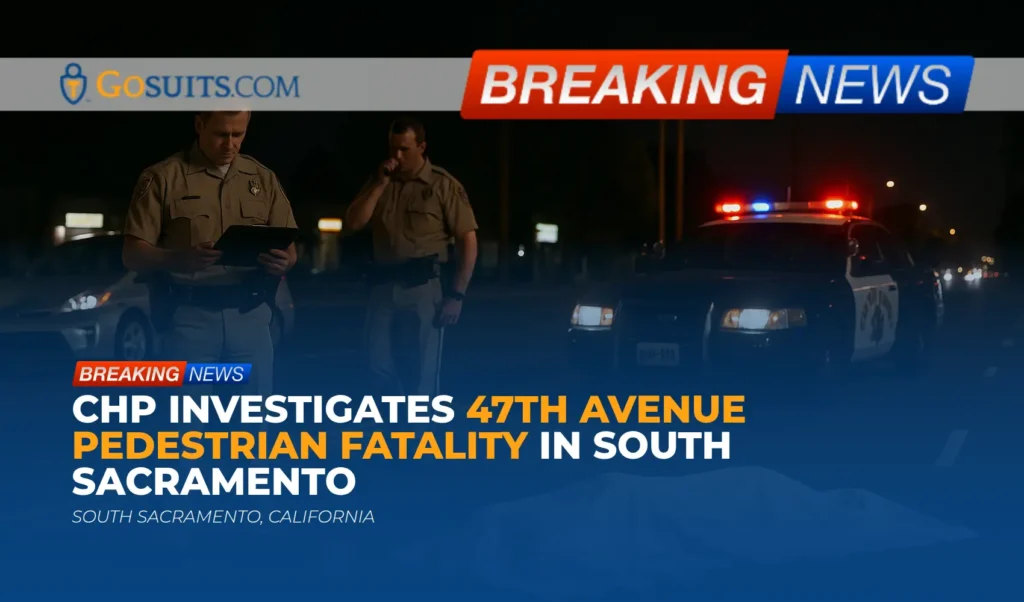- What we know about the State Highway 121 truck crash in McKinney
- Immediate steps after a highway truck crash
- Who may be liable in a Texas highway truck crash
- Preserving evidence and why time matters
- Getting official records and where to call
- Insurance issues and recorded statements
- Common injuries and supportive resources
- Safety and crash trends involving large trucks
- How Texas law frames responsibility after roadway crashes
- Practical guidance for families after a serious crash
- Commentary from Gosuits McKinney, Texas Personal Injury Attorney
- Why acting promptly matters
- Reliable resources and references
What we know about the State Highway 121 truck crash in McKinney
A truck crash on the southbound lanes of State Highway 121, also known as the Sam Rayburn Tollway, in McKinney prompted the closure of the southbound lanes. The reported date of the incident is October 22, 2025. Early public reports focused on the traffic impact, with multiple lanes shut down while responders worked the scene. Details about the number of vehicles involved, injuries, or contributing factors were not publicly confirmed at the time of the initial traffic alert. When authorities close several lanes after a tractor-trailer incident, it often indicates a serious collision, a complex recovery of the vehicle, or debris that requires extended cleanup for public safety.
State Highway 121 in McKinney is a high-speed corridor that carries commuters and heavy commercial traffic through Collin County. When a big rig is involved in a collision on a limited-access tollway, responders may need to manage fuel leaks, damaged cargo, and secondary hazards, which can extend closures. A full assessment from a civil perspective typically requires official reports, photographs, and, if available, commercial vehicle inspection findings.
Immediate steps after a highway truck crash
For those involved in or affected by a major highway truck crash, the first hours and days are overwhelming. Safety and medical care come first. After that, documentation and careful communication are important to protect health and legal rights.
Health and documentation
- Seek medical evaluation promptly. Some injuries, including concussion and internal trauma, may not be obvious at the scene. Timely diagnosis can protect health and create a clear medical record that connects injuries to the crash.
- Collect and preserve what you can. If safe and possible, save photos of the scene, vehicle positions, skid marks, road debris, and roadway conditions. Preserve clothing and personal items from the day of the crash. Keep all medical discharge paperwork and billing statements.
- Identify witnesses. Write down names, phone numbers, and brief summaries of what witnesses reported seeing. Independent witnesses can be crucial when liability is disputed.
Communications
- Be cautious with insurance communications. Statements given to any insurer, including your own, can be used later to question fault or the extent of injuries. It is prudent to consult an attorney before giving any recorded statement or signing any forms.
- Request the official crash report. In Texas, crash reports are maintained by the Texas Department of Transportation. See the section below on how to obtain records.
Who may be liable in a Texas highway truck crash
Commercial truck cases can involve multiple responsible parties. A careful review of the facts and the regulations that apply to motor carriers helps determine who should be held accountable. Potentially responsible parties include:
- Truck driver. Driver error can involve speed too fast for conditions, following too closely, distraction, fatigue, or failure to maintain lane. Drivers of commercial motor vehicles are subject to federal hours of service and other safety regulations.
- Motor carrier or trucking company. The company may be responsible for negligent hiring, training, supervision, or retention. It may also be liable for failing to enforce hours of service limits, inadequate maintenance, or unsafe dispatch practices that pressure drivers to hurry.
- Vehicle owner, maintenance contractor, or lessor. Mechanical failures, such as brake or tire issues, can point to negligent inspection or maintenance.
- Cargo loader or shipper. Unsecured or improperly balanced cargo can cause loss of control or rollover.
- Other motorists. Sudden lane changes, cutoffs, or unsafe merging by other drivers can trigger or worsen a chain reaction on a fast-moving tollway.
- Roadway conditions. In limited circumstances, a roadway defect or missing device may be implicated. Claims involving government entities require additional notice steps and often have shorter deadlines.
Commercial trucks are regulated by federal and state rules that set minimum safety standards. Key issues in many truck cases include electronic logging device data for hours of service, engine control module data for speed and braking, pre- and post-trip inspection records, driver qualification files, vehicle maintenance logs, and cargo securement documentation. Preserving this information quickly is essential, since some data can be overwritten or lost during normal operations.
Preserving evidence and why time matters
Evidence in a highway truck crash can fade quickly. Skid marks wear away, debris is cleared, and electronic data can be overwritten when the truck is returned to service. Early preservation steps help ensure a fair and accurate reconstruction.
- Send a preservation letter. A written notice to the motor carrier requesting that relevant evidence be preserved, including electronic data, paper records, and physical components, can help prevent loss of key proof.
- Secure vehicle inspections. When feasible, inspections by qualified professionals can document brake condition, tire condition, lights, and any post-crash defects.
- Obtain scene materials. Photographs, traffic camera footage, and 9-1-1 audio can provide valuable timing and sequence details. Public records requests may be needed to obtain some of these items.
- Track medical progression. Keep a detailed timeline of symptoms, treatments, and work impacts. This helps tie injuries to the crash and shows their real-world effect.
Getting official records and where to call
Official records can answer what happened, where, and how. In a commercial truck crash, several agencies may have records. Below are starting points for obtaining information related to a crash on State Highway 121 in McKinney.
Police crash reports
- Texas Department of Transportation crash reports. In Texas, the long-form crash report is maintained by the Texas Department of Transportation. Individuals who are legally entitled to a copy can obtain it through TxDOT’s crash reports process. Begin at the TxDOT website and follow instructions for requesting a CR-3 crash report.
Medical examiner and autopsy records
- Collin County Medical Examiner. For a fatality, the Collin County Medical Examiner handles postmortem examinations in this area. Families can inquire about autopsy status, reports, and death certificates through the county medical examiner’s office.

Commercial vehicle information
- Commercial vehicle safety. The Texas Department of Public Safety oversees commercial vehicle enforcement and may conduct inspections in certain circumstances.
- Federal motor carrier regulations. The Federal Motor Carrier Safety Administration publishes trucking safety rules, including hours of service and vehicle maintenance standards.
Public information requests
- Texas Public Information Act process. Many records held by state and local agencies are accessible through a request under the Texas Public Information Act. The Office of the Attorney General provides plain-language guidance on how to request public information and what is available.
When requesting records, include date, time frame, roadway, direction of travel, and any known reference points. For tollway incidents, note that State Highway 121 through McKinney is the Sam Rayburn Tollway segment, which helps agencies locate the right incident file.
Insurance issues and recorded statements
Insurance after a truck crash can be complex, since multiple policies may be involved, including the motor carrier’s liability coverage, excess coverage, the driver’s coverage if different, and personal auto policies for any non-commercial vehicles involved.
- Be careful before giving statements. Insurance adjusters often request recorded interviews quickly. What is said can be used later to dispute fault or injuries. It is wise to consult with an attorney first to understand rights, the scope of coverage, and how to avoid common pitfalls.
- Medical payment and PIP. Some personal auto policies have medical payments or personal injury protection benefits that can help with immediate expenses. These benefits do not determine fault for the overall case.
- Property damage. Document vehicle damage thoroughly with photos and repair estimates. Keep receipts for towing, rental vehicles, and personal property losses.
- Future care. Do not rush to settle bodily injury claims before understanding long-term medical needs. Early settlements sometimes do not reflect the full scope of care, therapy, or lost time from work.
If a claim will be made with any insurer, getting a free consultation with a personal injury attorney before contacting insurance can help clarify the process. Statements made to insurance can be used later, so careful preparation is important.
Common injuries and supportive resources
High-speed tollway collisions involving large trucks can cause severe injuries due to size and weight differences between a tractor-trailer and a passenger vehicle. Common injuries include traumatic brain injuries, spinal trauma, internal injuries, fractures, and psychological trauma. Even when injuries first seem minor, the forces involved can cause delayed-onset pain or neurological symptoms.
Recovery often requires multidisciplinary care. Some families also face sudden financial strain from missed work and medical bills. When a fatality occurs, grief and practical needs can be overwhelming. Support can include counseling, grief support, and community resources.
- Mental health support. The U.S. Department of Health and Human Services maintains information on behavioral health resources.
- Victim services. Local victim assistance programs may be accessible through city or county agencies. The Texas Public Information Act guidance can help locate responsive records that point to local services tied to a particular incident.
Safety and crash trends involving large trucks
Federal and state safety agencies publish data that give context for highway truck crashes. Understanding trends can help families make sense of the risk environment on major roadways like State Highway 121.
- National context. The National Highway Traffic Safety Administration tracks fatalities involving large trucks. Nationally, thousands of people are killed each year in crashes involving large trucks.
- Texas context. Texas consistently reports a high number of roadway fatalities, partly due to population, miles driven, and heavy commercial traffic. TxDOT publishes crash information and safety initiatives that aim to reduce serious injuries and deaths.
- Regulatory backdrop. The Federal Motor Carrier Safety Administration issues and enforces regulations for commercial carriers, including hours of service limits intended to prevent fatigue, requirements for vehicle inspection and maintenance, and rules for cargo securement.
While each crash is unique, common contributing factors in truck collisions include speed too fast for conditions, following distance issues, fatigue, distraction, and mechanical problems. Post-crash investigations often look at log data, telematics, braking and tire condition, and compliance with required inspections.
How Texas law frames responsibility after roadway crashes
In civil cases, Texas law assigns responsibility based on negligence and proportionate responsibility. Several provisions can affect outcomes:
- Proportionate responsibility. If more than one party contributed to a crash, Texas law allocates fault among them. An injured person’s compensation can be reduced by their percentage of responsibility, and recovery is generally barred if their responsibility exceeds a certain threshold. See Chapter 33 of the Texas Civil Practice and Remedies Code for general guidance.
- Time limits. Texas has deadlines for filing civil claims. Many personal injury claims must be brought within two years of the incident, and wrongful death claims also have specific deadlines. Some claims against government entities require earlier notice. See Chapter 16 of the Texas Civil Practice and Remedies Code for limitation periods.
- Commercial carrier duties. Federal and state rules require carriers to vet drivers, monitor hours, maintain vehicles, and secure cargo. Violations can inform civil responsibility.
Every case turns on its facts. A careful review of the crash scene, vehicles, witnesses, and safety records is essential to understand how and why the crash occurred and how responsibility should be allocated.
Practical guidance for families after a serious crash
When a major truck crash disrupts a family, a practical plan can help. These steps are general and intended to support informed decisions.
- Organize records. Keep a folder with the crash report number, case number if available, medical records, billing statements, photographs, and insurance correspondence.
- Track out-of-pocket costs. Maintain a log of expenses, travel mileage for medical care, time missed from work, and any home care needs.
- Beware of early settlement offers. Early offers can arrive before the full scope of injuries is known. Consider the long-term impact and consult with counsel before agreeing.
- Consider an evidence preservation request. Especially in commercial truck crashes, an early written request to preserve electronic logging data, engine data, maintenance records, and cargo documents can be important.
- Consult before contacting insurers. What is said to any insurer can be used later. A free consultation with a personal injury attorney can clarify rights, valuation, and risks before any recorded statements.
Commentary from Gosuits McKinney, Texas Personal Injury Attorney
Our thoughts are with everyone affected by the State Highway 121 truck crash in McKinney. High-speed corridor incidents can change lives in seconds, and the uncertainty that follows is emotionally and practically difficult. This article is provided for educational and general information, intended to help the community understand common issues that arise after major truck crashes.
From a civil standpoint, a closure of multiple southbound lanes suggests a significant event that deserves a careful review. In commercial vehicle cases, the most important early questions include whether the driver was rested and compliant with hours of service rules, whether the tractor and trailer were properly maintained, and whether cargo was loaded and secured as required. On a fast-moving tollway, small lapses in following distance or speed can have outsized consequences, and electronic data from the truck and logging devices can be decisive in understanding what happened.
Insurance companies and large transportation firms manage claims every day, and they often move quickly to shape the narrative. Adjusters may request recorded statements soon after an incident or ask injured people to sign medical authorizations that are broader than necessary. Without context, it is easy to underestimate the future impact of injuries or to accept a version of events that does not reflect the full truth. Being informed, preserving evidence, and understanding the rules that apply to commercial carriers can help level the playing field.
Obtaining a free consultation early provides clarity about rights, the types of insurance that may apply, and how to avoid common missteps that can reduce the value of a claim. It also helps ensure that critical evidence, such as electronic logging data and engine control module information, is preserved before it is lost through routine operations.

Why acting promptly matters
- Evidence changes quickly. Skid marks fade, debris is cleared, and electronic data can be overwritten during regular fleet use. Early action increases the chance that critical information will be preserved.
- Deadlines apply. Texas law sets time limits for civil claims, and some notices, especially those involving government-related entities, can be shorter than the general two-year window. Acting now helps avoid missed deadlines.
- Medical documentation is strongest early. Prompt evaluation ties symptoms to the crash and supports appropriate care plans. Early records often carry the most weight.
- Insurance communication can affect outcomes. Statements to insurers may be used later to dispute responsibility or injuries. Planning communications before they occur reduces risk.
- Financial stability. Understanding available coverages, including medical payments or PIP, can provide near-term support while longer-term issues are evaluated.
Reliable resources and references
Truck safety and crash data
- Federal Motor Carrier Safety Administration, Hours of Service
- FMCSA, Safety Data and Statistics
- National Highway Traffic Safety Administration, Traffic Fatalities
Texas crash reports and safety information
- Texas Department of Transportation, Crash Reports and Safety Information
- Texas Department of Public Safety, Commercial Vehicle Enforcement
Texas law and timelines
- Texas Civil Practice and Remedies Code, Chapter 33, Proportionate Responsibility
- Texas Civil Practice and Remedies Code, Section 16.003, Limitations Periods
Public records and support






